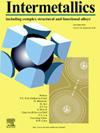Optimizing the glass forming ability and soft magnetic properties of FeNiB nanocrystalline alloys through carbon addition
IF 4.3
2区 材料科学
Q2 CHEMISTRY, PHYSICAL
引用次数: 0
Abstract
Fe-based nanocrystalline alloys with high saturation magnetic flux density (Bs) show significant potential for electrical and electronic applications. However, their large-scale industrial production remains challenging due to limited glass forming ability (GFA). In this work, we systematically investigated the GFA, thermal stability and soft magnetic properties of Fe85-xNi2B13Cx (x = 0, 1, 2, 3, 4) alloys. The experimental results indicated that appropriate carbon addition can significantly enhance both GFA and soft magnetic properties. Specially, when the carbon content exceeds 2 at. %, the as-spun alloy ribbons retain a fully amorphous structure at a wheel speed of 40 m/s. As the carbon content increases from 0 to 4 at. %, Tx1 rises from 628 K to 688 K and Tx2 increases from 748 K to 768 K, while the C2 alloy maintains a substantial ΔT over 104 K. After rapid annealing at 753 K for 6 s, the Fe83Ni2B13C2 alloy exhibits improved soft magnetic properties, achieving Bs of 1.87 T and Hc of 8.2 A/m. This research provides valuable insights into the development and practical industrial application of Fe-based soft magnetic nanocrystalline alloys with high Bs.
通过添加碳优化FeNiB纳米晶合金的非晶形成能力和软磁性能
具有高饱和磁通密度(Bs)的铁基纳米晶合金在电气和电子领域具有巨大的应用潜力。然而,由于有限的玻璃成形能力(GFA),它们的大规模工业生产仍然具有挑战性。本文系统地研究了Fe85-xNi2B13Cx (x = 0,1,2,3,4)合金的GFA、热稳定性和软磁性能。实验结果表明,适当的碳添加可以显著提高GFA和软磁性能。特别是当含碳量超过2 at时。%时,当轮速为40 m/s时,纺丝态合金带仍保持完全非晶态结构。随着碳含量从0增加到4 at。%, Tx1从628 K增加到688 K, Tx2从748 K增加到768 K,而C2合金在104 K以上保持了相当大的ΔT。经753 K快速退火6 s后,Fe83Ni2B13C2合金的软磁性能得到改善,合金的Bs为1.87 T, Hc为8.2 A/m。本研究为高硼铁基软磁纳米晶合金的开发和实际工业应用提供了有价值的见解。
本文章由计算机程序翻译,如有差异,请以英文原文为准。
求助全文
约1分钟内获得全文
求助全文
来源期刊

Intermetallics
工程技术-材料科学:综合
CiteScore
7.80
自引率
9.10%
发文量
291
审稿时长
37 days
期刊介绍:
This journal is a platform for publishing innovative research and overviews for advancing our understanding of the structure, property, and functionality of complex metallic alloys, including intermetallics, metallic glasses, and high entropy alloys.
The journal reports the science and engineering of metallic materials in the following aspects:
Theories and experiments which address the relationship between property and structure in all length scales.
Physical modeling and numerical simulations which provide a comprehensive understanding of experimental observations.
Stimulated methodologies to characterize the structure and chemistry of materials that correlate the properties.
Technological applications resulting from the understanding of property-structure relationship in materials.
Novel and cutting-edge results warranting rapid communication.
The journal also publishes special issues on selected topics and overviews by invitation only.
 求助内容:
求助内容: 应助结果提醒方式:
应助结果提醒方式:


